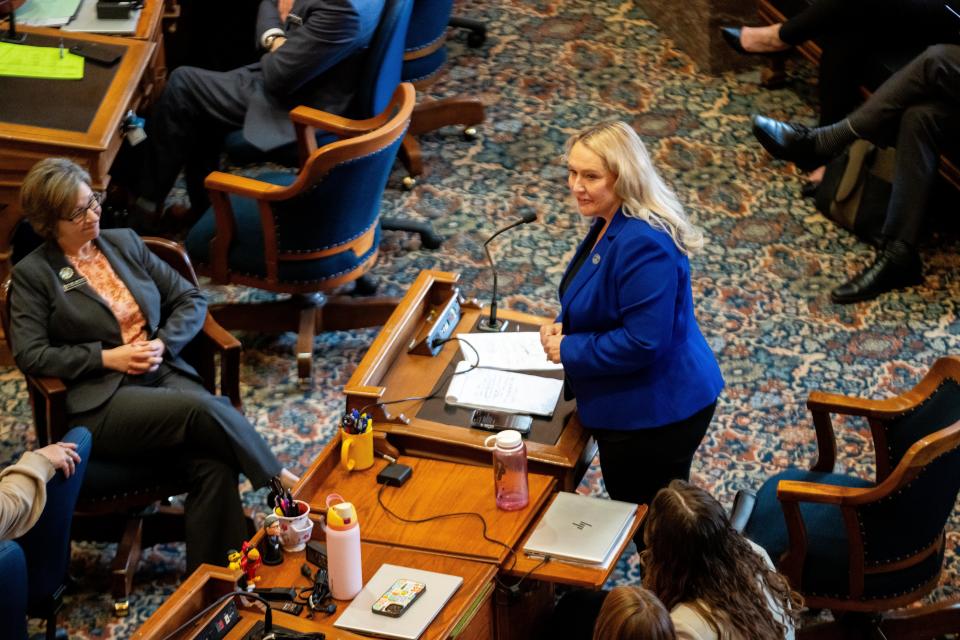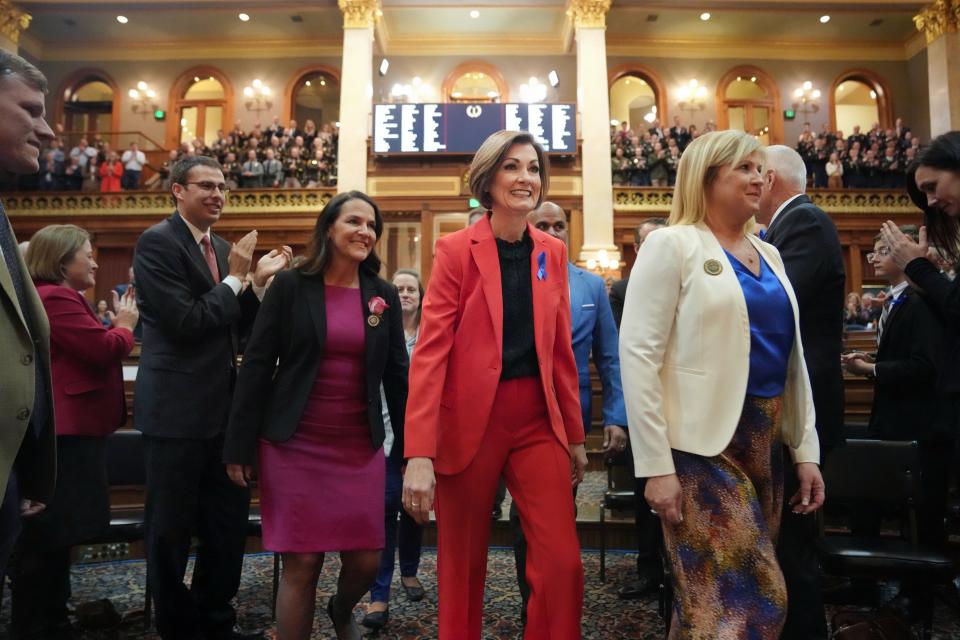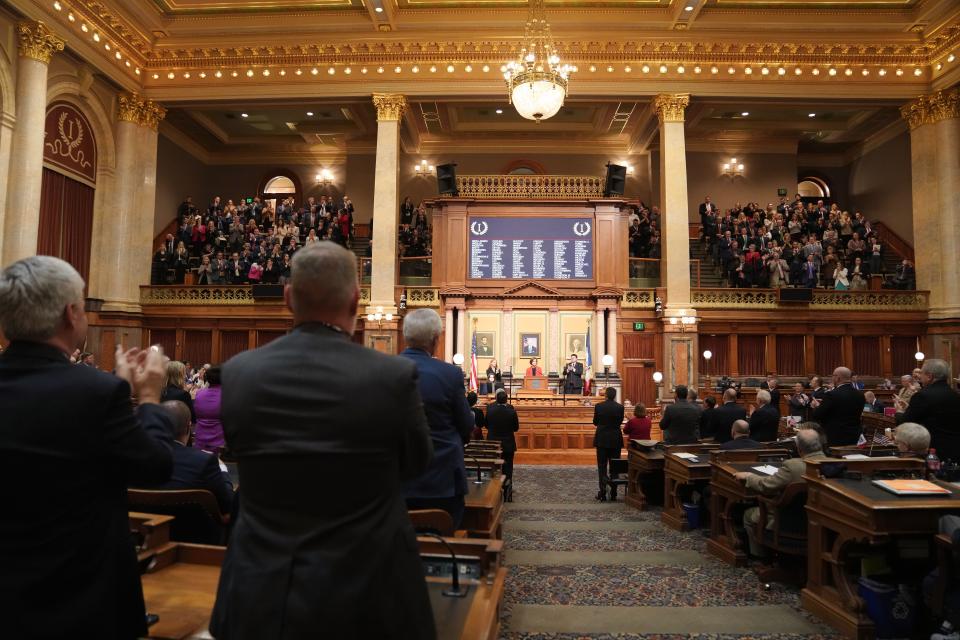Kim Reynolds wants to cut Iowa taxes — again. Here's how it would work and who gets a break.
- Oops!Something went wrong.Please try again later.
Iowans would see their income taxes cut further and faster under legislation proposed by Gov. Kim Reynolds.
Reynolds’ wide-ranging tax bill, House Study Bill 543, would also cut the unemployment taxes paid by businesses and reduce taxes on child care centers.
She laid out the tax proposal in her annual Condition of the State address on Jan. 8. Other parts of the governor’s agenda this year include overhauling special education services in Iowa, boosting teacher pay and consolidating Iowa’s boards and commissions.
Here’s a look at what’s in Reynolds’ tax cut legislation.
How Gov. Kim Reynolds wants to further drop Iowa’s income tax
After signing several rounds of tax cuts during her time as governor, Reynolds is again proposing to lower Iowans’ personal income tax rate.
Iowa’s top tax rate is 5.7% as the state phases in a 2022 law that is already scheduled to bring down the individual income tax rate to a 3.9% flat tax by 2026.
Reynolds’ bill would speed up that process and make further cuts by dropping Iowa’s income tax rate to a flat tax of 3.65% for 2024 and make the change retroactive to the beginning of the year.
Iowans would see their income tax rate further drop to 3.5% in 2025.
If the bill passes, Reynolds has said Iowans would see savings right away from a lower tax withholding by employers.
“There would be no waiting. The cuts would start to show up in paychecks this year,” Reynolds said in her 2024 Condition of the State address. “So let’s not hesitate.”
House Minority Leader Jennifer Konfrst, D-Windsor Heights, said plenty of low-income Iowans don’t pay income taxes and would not benefit from the cut.
“Regardless of what comes forward, that’s still 500,000 Iowans who will not receive any benefit from the governor and Republicans’ tax cuts,” she said. “And so we need to be looking at ways to ensure that middle class and lower income Iowans are getting the benefit of tax cuts when they’re happening.”

Senate Minority Leader Pam Jochum, D-Dubuque, said she’s heard Senate Republicans are writing their own tax bill, independent of Reynolds’ bill.
“So that would lead me to believe that the governor’s proposal is not moving forward,” she said.
How Iowa businesses would pay less in unemployment taxes
Businesses’ top tax rate for unemployment taxes would drop to 5.4% in 2025, down from the current rate of 7%, if Reynolds’ bill becomes law.
And employers would have to pay unemployment taxes on only one-third of the statewide average weekly wage per employee, down from two-thirds under current law.
That amounts to paying taxes on roughly $18,000 of wages per employee, down from about $36,000 under current law.
Reynolds’ office estimates the change will result in $800 million in savings for employers over five years.

The bill would also reduce the number of tax tables that determine how much businesses must pay in unemployment taxes. And it would put in place a lower threshold for reaching the best tax rate for businesses.
Currently, Iowa’s unemployment trust fund is required to reach about $1.6 billion in order for businesses to pay the lowest rate. Reynolds’ bill would change that to about $900 million.
The fund has about $1.8 billion.
Konfrst said she believes the unemployment trust fund is “artificially propped up” because Republicans passed a law in 2022 cutting the maximum number of weeks Iowans can receive unemployment benefits from 26 weeks to 16 weeks.
“I would imagine that the fund has more money because they just gutted unemployment services for Iowans and they cut it in half,” she said. “And so fewer people are seeking out the unemployment.”
Child care facilities would be taxed as residential properties, not commercial
Commercial child care centers would see their property taxes lowered by taxing them at the same rate as in-home child care providers.
Instead of being taxed as commercial properties, child care centers would be taxed as residential properties under Reynolds’ bill.

Iowa's cash reserve and economic emergency funds would be combined
Two of Iowa’s reserve funds would be combined into one, under Reynolds’ bill.
The economic emergency fund would be combined with the state’s cash reserve fund, which would be required to maintain a balance of 12.5% of estimated state revenue each year.
The money in the cash reserve fund can be used only in certain circumstances, including for “nonrecurring emergency expenditures,” or to pay expenses authorized by the state’s executive council or for cash flow purposes as long as the money is returned to the cash reserve fund by the end of each fiscal year.
Stephen Gruber-Miller covers the Iowa Statehouse and politics for the Register. He can be reached by email at sgrubermil@registermedia.com or by phone at 515-284-8169. Follow him on Twitter at @sgrubermiller.
This article originally appeared on Des Moines Register: Here's what's in Gov. Kim Reynolds' plan to cut Iowans' income taxes

